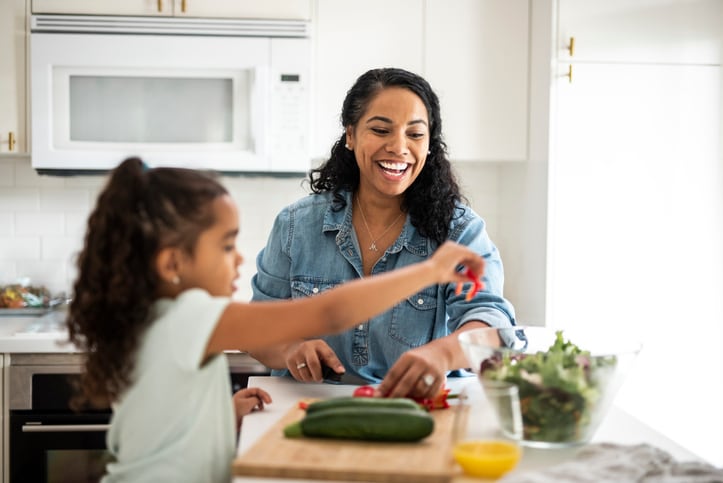Meal Prep to Better Manage Your Diabetes

Involve your family to plan and prepare meals that are diabetes-friendly.
Meal prepping, or preparing your meals ahead of time, can help you better manage your diabetes. Read more for tips on how to get started.
A healthy and balanced diet is a key part of diabetes management, and meal prep can help—especially during times of uncertainty when your schedule may be disrupted. Feeling overwhelmed or anxious can lead to shortcuts in the kitchen, and you may end up eating unhealthy foods. Frozen pizza or fast food may be easy choices, but not the best choices for your health.
When you plan your meals and make them in advance, you’ll be less tempted to eat foods that aren’t diabetes-friendly. This can give you some control over your diabetes management even at times when other things can feel out of control.
How to Get Started
Meal planning can be broken down into 5 simple steps.
Step 1: Talk with your family about foods they like. Think about how they can be a part of well-balanced meals that help you avoid high and low blood sugar levels.
Step 2: Shop at home. Before you head to the store or order your groceries for delivery, look at what you have at home. Do you need to use up produce before it spoils? Make a list of the foods you have on hand to help you choose recipes. Low on staples such as beans, oil, or pasta? Add them to your grocery list.
Step 3: Find recipes that match your family’s tastes and your health goals. Start by looking at recipes you know your family loves. Are there ways to make them healthier? If you want to add new meals, save recipes from newspapers, magazines, or food blogs.
Step 4: Using what you learned in steps 1–3, fill out a diabetes meal planner [PDF – 30KB] to track what you plan to make and when. Consider:
- Making meals during a time of day or day of the week when you are less rushed.
- Choosing one day to make meals in advance.
- Using a theme for each day of the week. Your family may enjoy the routine, and it can be fun! Meatless Mondays, Taco Tuesdays, or Whole-Grain Wednesdays are just a few ideas.
Interactive tools can help you with healthy meal planning.
Step 5: Make your grocery list. Whether you use a pen and paper or an app, know what you need—and what you don’t—before you shop.
Tips for the Kitchen
When you’re ready to start cooking, here are some tips to make meal prep as easy and efficient as possible:
- Start with foods that will take the longest to cook, such as proteins like chicken, whole grains like brown rice, dried beans, and roasted vegetables.
- While foods are baking or simmering on the stovetop, wash and chop vegetables or prepare other foods that don’t need to be cooked.
- Make extra portions of your recipe for leftovers. You can eat leftovers later in the week or use them to make a new meal. For example, try shredding leftover baked chicken and adding it to a stew, salad, or sandwich.
- Make quick snacks for the week, such as hard-boiled eggs, fresh cut fruit, or small salads. If you make a green salad that uses dressing, don’t add the dressing until right before you eat it.
- Put servings of the prepared meal in individual containers. This helps with portions, and they’re ready to grab if you pack your lunch.
Storing Your Meals
Put your finished meals in the fridge or freezer and pull them out during the week. Here are some tips on how to keep foods fresh:
- Cooked foods should be eaten with 7 days. Some foods should be eaten sooner. See the Food Storage Chart.
- Keep fresh foods, such as produce, toward the front of your fridge and at eye level so you don’t forget about them.
- Label containers with the date you prepared the food. You’ll know what to eat first and when they need to be eaten by.
- If you freeze meals, store them in airtight containers.
Additional Tips
Once you’ve done meal planning for a few months, you’ll discover which meals your family likes and which ones are easiest to make ahead of time. Look for sales and coupons to stock up on your “go-to” ingredients that have a long shelf life – beans, pasta, rice, whole grains, and healthy oils, such as canola and olive oil.
Be sure to rotate recipes so you’re not always making the same thing. And continue to look for new healthy recipes to add to your collection.
Don’t be afraid to ask for help. Meal planning and prepping when you have diabetes can be tricky, but the payoff can be great. Talk with your doctor, diabetes educator, or a dietician for help.
More Information






















.png)











No hay comentarios:
Publicar un comentario